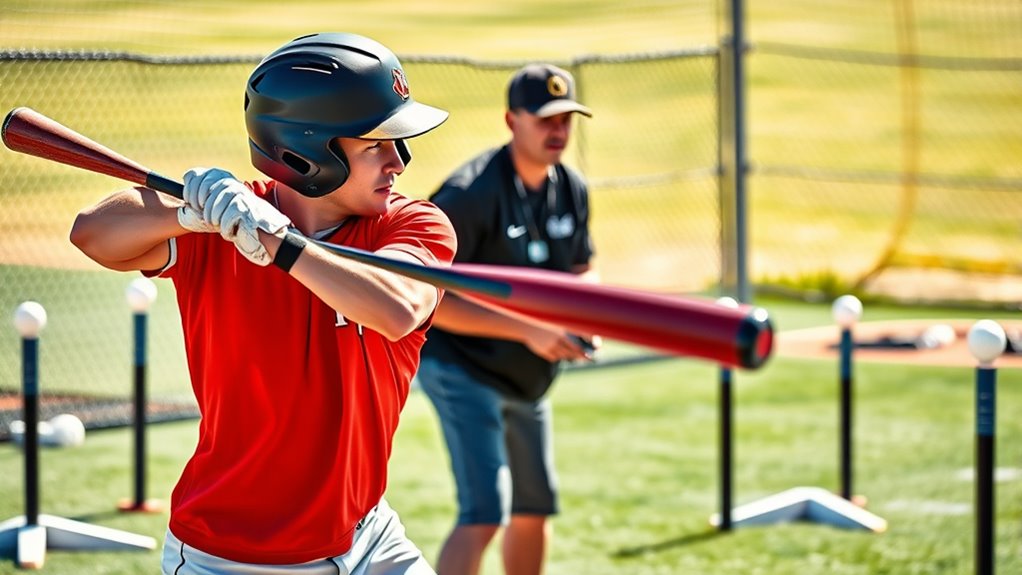To boost your batting average, focus on hitting drills that improve your timing, hand-eye coordination, and swing mechanics. Incorporate drills like soft-toss for power, pitch recognition exercises, and resistance-based swings to increase bat speed. Practice tracking pitches early and adjusting your timing for better contact. Using visual cues and recording your swings can also help refine your technique. Keep practicing these methods consistently, and you’ll see your performance rise—there’s much more to explore!
Key Takeaways
- Incorporate soft-toss and front-toss drills to improve timing and hand-eye coordination.
- Use resistance bands and weighted bats to increase swing speed and power.
- Practice pitch recognition with visual cues and tracking drills to anticipate pitches early.
- Combine quick-twitch muscle exercises with reaction drills to enhance bat speed and reaction time.
- Record swings and analyze mechanics to refine timing, consistency, and contact quality.

Improving your batting average requires more than just practice; it demands targeted drills that develop your timing, hand-eye coordination, and swing mechanics. One of the most effective ways to do this is by focusing on increasing your bat speed and sharpening your pitch recognition skills. When you work on bat speed, you’re enabling yourself to generate more power and react faster to pitches, giving you a pivotal edge at the plate. Enhanced bat speed allows you to drive the ball with greater force, increasing your chances of hitting line drives and extra-base hits. To boost your bat speed, incorporate quick-twitch drills, such as swinging weighted bats or resistance bands, which strengthen your muscles and improve your swing speed over time.
Simultaneously, honing your pitch recognition is essential for making consistent contact. The better you can identify the type and location of a pitch early in its trajectory, the more prepared you are to make solid contact. To develop this skill, set up drills where you focus solely on tracking pitches from the pitcher’s hand to the catcher’s mitt. Use visual cues, like the pitcher’s grip or arm angle, to anticipate the pitch type. Practice with pitching machines or live pitchers, but slow down the process initially—pause and analyze each pitch, then gradually increase speed as your recognition improves. This not only sharpens your eye but also helps you develop a faster reaction time, which is essential for catching up to high-velocity pitches. Incorporating visual training tools can further enhance your pitch recognition abilities and improve your overall batting performance.
Combining these two elements in your training creates a powerful feedback loop. When you improve pitch recognition, you can anticipate pitches more accurately, allowing you to set your timing and swing mechanics more effectively. As your timing improves, you’ll naturally increase your bat speed because you’re swinging with more confidence and efficiency. A good drill to integrate both aspects involves soft-toss or front-toss sessions where you focus on recognizing pitches early and swinging with maximum bat speed. Record your swings and analyze your timing and power. Over time, the consistency of your contact will rise, and your batting average will follow suit.
Frequently Asked Questions
How Long Should a Typical Hitting Drill Session Last?
A typical hitting drill session should last about 30 to 45 minutes, allowing you to focus on key skills like your batting stance and pitch recognition. You want enough time to practice swings, work on timing, and refine technique without fatigue setting in. Break the session into smaller segments, such as drills for stance adjustments and pitch anticipation, to keep your practice effective and engaging.
What Equipment Is Essential for Effective Hitting Drills?
You can’t build a house without the right tools, and the same goes for hitting drills. Essential equipment includes a bat suited to your size, a helmet for safety, and a tee or pitching machine to refine your batting stance and hitting mechanics. Batting gloves can improve grip, while a net helps you practice consistently. Having these items on hand guarantees your drills are effective and your progress steady.
How Often Should I Incorporate Hitting Drills Into My Practice?
You should incorporate hitting drills into your practice at least 3 to 4 times a week to see steady improvement. Focus on maintaining a consistent batting stance and enhancing your mental focus during each session. Regular practice helps reinforce proper mechanics, build muscle memory, and boost confidence. Remember, consistency is key, so stay committed and keep your mental focus sharp to maximize the benefits of each drill.
Can Hitting Drills Improve Power as Well as Average?
Imagine your swing as a mighty river, capable of carving canyons with the right flow. Hitting drills can definitely improve your power development by refining your swing mechanics, allowing you to generate more force behind each hit. While they primarily boost your batting average, with targeted focus, these drills also help build strength and timing, translating into more powerful swings. Consistent practice turns that river into a force of nature.
Are There Specific Drills Recommended for Beginner Versus Advanced Players?
For beginners, focus on basic drills that reinforce a solid batting stance and improve pitch recognition, like tee work and soft toss. Advanced players should incorporate timing and spatial awareness drills, such as live batting against varied pitches. Both levels benefit from video analysis to refine mechanics, but tailored drills help develop skills efficiently, making your swing more consistent and your ability to recognize pitches sharper.
Conclusion
Now that you’ve got these 10 powerful drills, your batting average is about to take a serious leap. But here’s the secret: consistency is your ultimate game-changer. Keep practicing these drills regularly, and you might just surprise everyone — including yourself — when the game’s on the line. Are you ready to discover your full hitting potential? Because the next at-bat could be your moment to shine, and these drills could make all the difference.









